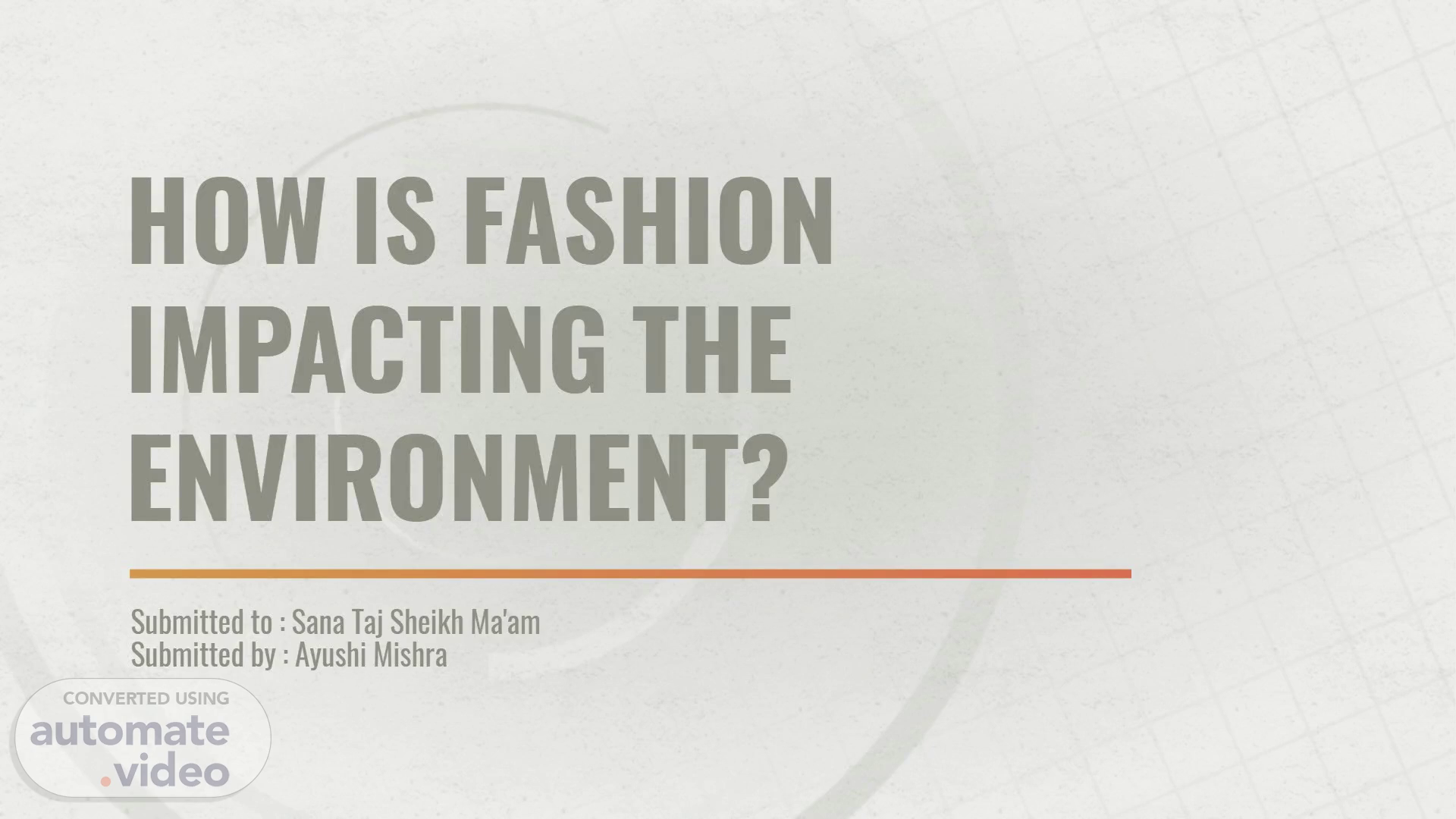Page 1 (0s)
. HOW IS FASHION IMPACTING THE ENVIRONMENT? Submitted to : Sana Taj Sheikh Ma'am Submitted by : Ayushi Mishra.
Page 2 (8s)
. The impact of fashion industry on environment > > > > > Excessive usage of water Plastic microfibers Excessive consumption of clothing Usage of viscose Food insecurity > > > > > Resource depletion Climate change Human rights abuse Water pollution Air pollution.
Page 3 (19s)
. .
Page 4 (25s)
. Some important facts > > Clothing production has roughly doubled since 2000. While people bought 60% more garments in 2014 than in 2000, they only kept the clothes for half as long. In total, up to 85% of textiles go into landfills each year. That's enough to fill the Sydney harbor annually..
Page 5 (41s)
. > > Washing clothes, meanwhile, releases 500,000 tons of microfibers into the ocean each year — the equivalent of 50 billion plastic bottles. Many of those fibers are polyester, a plastic found in an estimated 60% of garments. Producing polyester releases two to three times more carbon emissions than cotton, and polyester does not break down in the ocean..
Page 6 (59s)
. > A 2017 report from the International Union for Conservation of Nature (IUCN) estimated that 35% of all microplastics — very small pieces of plastic that never biodegrade — in the ocean came from the laundering of synthetic textiles like polyester. > The fashion industry is resp fo 10% o hu emissions..
Page 7 (1m 13s)
. > That's more emissions than all international flights and maritime shipping combined. > The fashion industry is also the second-largest consumer of water worldwide..
Page 8 (1m 24s)
. > > That's because both the jeans and the shirt are made from a highly water-intensive plant: cotton. Fashion causes water-pollution problems, too. Textile dyeing is the world's second-largest polluter of water, since the water leftover from the dyeing process is often dumped into ditches, streams, or rivers..
Page 9 (1m 40s)
. In Uzbekistan, for example, cotton farming used up so much water from the Aral Sea that it dried up after about 50 years. Once one of the world's four largest lakes, the Aral Sea is now little more than desert and a few small ponds..
Page 10 (1m 55s)
. MICROFIBERS When washed, synthetic clothing sheds tiny plastic fragments known as microfibers. Microfibers are the most prevalent type of microplastic (plastic pieces less than 5 mm in diameter) found in the environment. Though we cannot see them, plastic microfibers are all around us..
Page 11 (2m 8s)
. Types of Microfibers 1 .Flat-weave microfiber : Flat-weave microfibre is one of the most durable forms of this textile, but it is not as absorbent as split-weave microfibre. ... 2. Split-weave microfibre. ... 3. Micromodal.. 4. Ultrasuede. ... 5. Prolen. ... 6. Terry microfibre. ... 7. Waffle weave microfibre. ... 8. Chenille microfibre..
Page 12 (2m 28s)
. Microfibers impacting environment Microfibers are synthetic fibers derived from petroleum that are so small that you cannot see it with the naked eye and filters can't even capture them..
Page 13 (2m 38s)
. > > Microfibers are too small to be filtered out by waste treatment plants, so they end up in our waterways and oceans. Once these fibers get into the local river and beyond, "they act like sponges, sucking up other pollutants around them," explains The Story of Stuff Project, which is raising awareness and seeking solutions to this issue..
Page 14 (2m 56s)
. Microfibers impact prevention > Wash synthetic clothes less frequently and for a shorter duration. Fill up your washing machine. Washing a full load results in less friction between the clothes and fewer fibers released..
Page 15 (3m 9s)
. Consider switching to liquid laundry detergent. Laundry powder "scrubs" and loosens more microfibers. Use a colder wash setting. Higher temperature can damage clothes and release more fibers..
Page 16 (3m 19s)
. > Dry spin clothes at low revs. Higher revolutions increase the friction between the clothes. > When you it down thu.
Page 17 (3m 29s)
. > Another device that will catch microfibers in your washing machine is Cora Ball, a hive-like ball made of recycled plastic that you put directly in the washing captures aro.
Page 18 (3m 40s)
. > > > Purchase a washing machine lint filter. These filters require more of an investment, but they will benefit your septic system and the environment. Speak up and tell clothing designers to choose natural fabrics that aren't prone to shedding. Tell your friends and family about microfiber pollution..
Page 19 (3m 55s)
. > > Avoid purchasing cheaply-made, "fast fashion" clothes, whenever possible. Buy clothes made from natural fibers such as cotton, linen, and wool. Natural fibers will eventually break down in the environment. Plastic fibers will never go away..
Page 20 (4m 10s)
. BIBLIOGRAPHY > > > > > https://www.google.com/ https://en.wikipedia.org/wiki/Main_Page https://www.weforum.org/agenda/2020/01/fashion-industry-carbon-unsustainable-en vironment-pollution/ https://www.intelligentliving.co/microfibers-what-you-can-do/ https://psci.princeton.edu/tips/2020/7/20/the-impact-of-fast-fashion-on-the-environ ment.
Page 21 (4m 33s)
. > > > > https://www.weforum.org/agenda/2020/01/fashion-industry-carbon-unsustainable-en vironment-pollution/ https://www.greenmatters.com/p/what-are-microfibers https://oceanservice.noaa.gov/facts/microplastics.html https://www.wxxymicrofibercloth.com/info/advantages-and-disadvantages-of-microfib er-30830832.htmI.
Page 22 (4m 53s)
. nox YINVHL.
